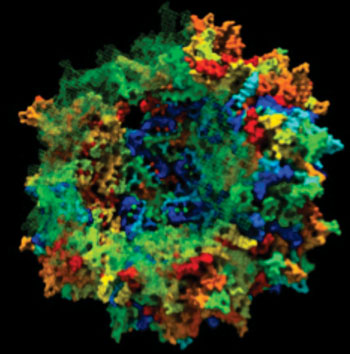Ancient Viruses Built from Computer Models May Improve Gene Therapy Delivery
By LabMedica International staff writers
Posted on 12 Aug 2015
An advanced computer modeling strategy was used to design ancient forms of adeno-associated viruses (AAVs), which were then synthesized in the laboratory for use as potential delivery vectors for gene therapy.Posted on 12 Aug 2015
AAV vectors have emerged as a gene-delivery platform with demonstrated safety and efficacy in a handful of clinical trials for monogenic disorders. However, limitations of the current generation of vectors—including rejection by the patient's immune system—often prevent broader application of AAV gene therapy. Efforts to engineer AAV vectors have been hampered by a limited understanding of the structure-function relationship of the complex multimeric icosahedral architecture of the particle.

Image: Artist\'s conception of an adeno-associated viral capsid in formation by ancestral sequence reconstruction (Photo courtesy of Dr. Eric Zinn, Harvard University Medical School).
To bypass these limitations investigators at Harvard University Medical School (Boston, MA, USA) built computer models of the AAC viral capsid using ancestral sequence reconstruction from inferred evolutionary intermediates. Computer model-derived sequences were synthesized in the laboratory and characterized for biological properties relevant to clinical applications.
Results published in the July 30, 2015, online edition of the journal Cell Reports described the generation of nine functional putative ancestral AAVs and the identification of Anc80, the predicted ancestor of the widely studied AAV serotypes 1, 2, 8, and 9, as a highly potent in vivo gene therapy vector for targeting liver, muscle, and retina.
"The vectors developed and characterized in this study demonstrate unique and potent biology that justify their consideration for gene therapy applications," said senior author Dr. Luk H. Vandenberghe, professor of ophthalmology at Harvard University Medical School. "We believe our findings will teach us how complex biological structures, such as AAVs (adeno-associated viruses), are built. From this knowledge, we hope to design next-generation viruses for use as vectors in gene therapy."
Related Links:
Harvard University Medical School













